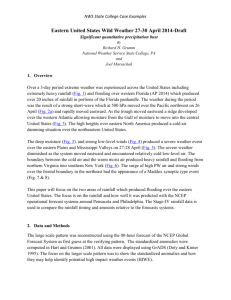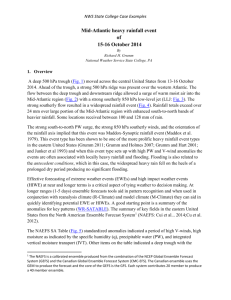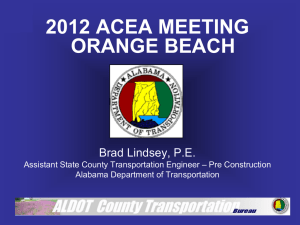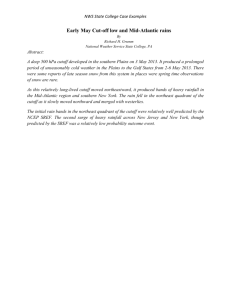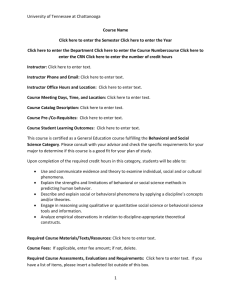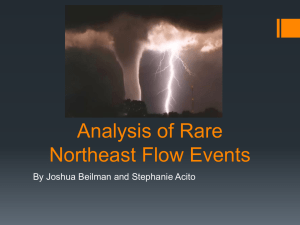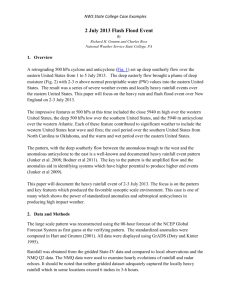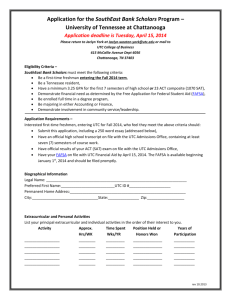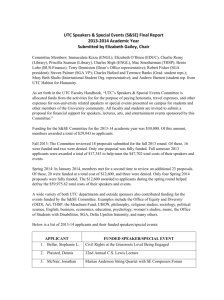14Oct2014
advertisement
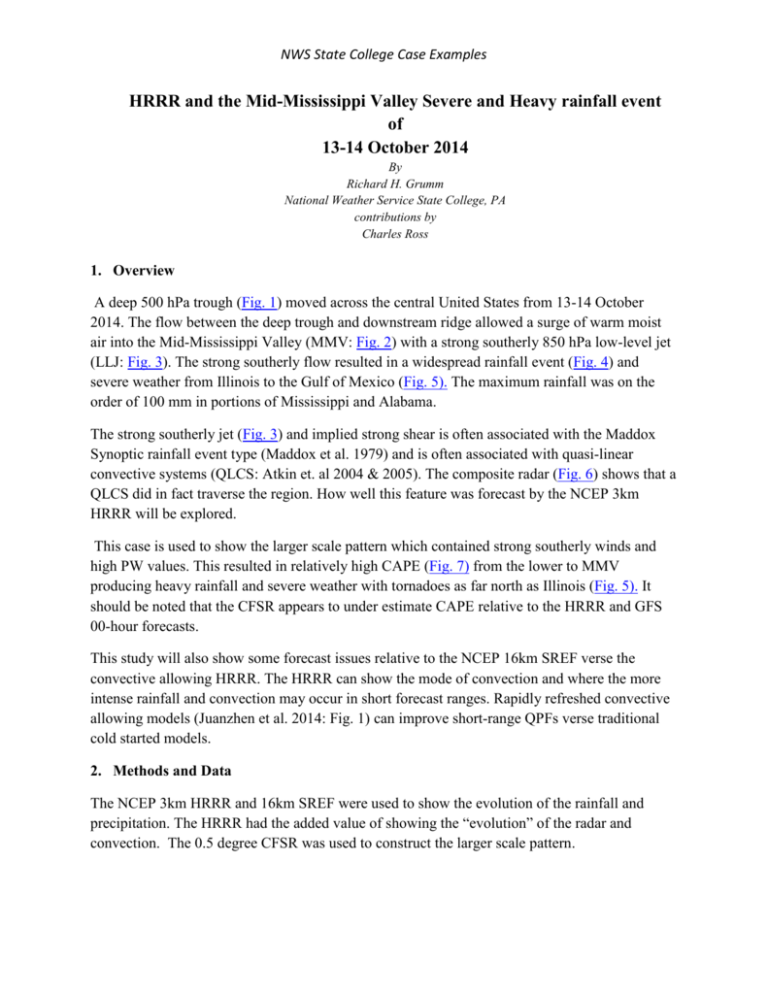
NWS State College Case Examples HRRR and the Mid-Mississippi Valley Severe and Heavy rainfall event of 13-14 October 2014 By Richard H. Grumm National Weather Service State College, PA contributions by Charles Ross 1. Overview A deep 500 hPa trough (Fig. 1) moved across the central United States from 13-14 October 2014. The flow between the deep trough and downstream ridge allowed a surge of warm moist air into the Mid-Mississippi Valley (MMV: Fig. 2) with a strong southerly 850 hPa low-level jet (LLJ: Fig. 3). The strong southerly flow resulted in a widespread rainfall event (Fig. 4) and severe weather from Illinois to the Gulf of Mexico (Fig. 5). The maximum rainfall was on the order of 100 mm in portions of Mississippi and Alabama. The strong southerly jet (Fig. 3) and implied strong shear is often associated with the Maddox Synoptic rainfall event type (Maddox et al. 1979) and is often associated with quasi-linear convective systems (QLCS: Atkin et. al 2004 & 2005). The composite radar (Fig. 6) shows that a QLCS did in fact traverse the region. How well this feature was forecast by the NCEP 3km HRRR will be explored. This case is used to show the larger scale pattern which contained strong southerly winds and high PW values. This resulted in relatively high CAPE (Fig. 7) from the lower to MMV producing heavy rainfall and severe weather with tornadoes as far north as Illinois (Fig. 5). It should be noted that the CFSR appears to under estimate CAPE relative to the HRRR and GFS 00-hour forecasts. This study will also show some forecast issues relative to the NCEP 16km SREF verse the convective allowing HRRR. The HRRR can show the mode of convection and where the more intense rainfall and convection may occur in short forecast ranges. Rapidly refreshed convective allowing models (Juanzhen et al. 2014: Fig. 1) can improve short-range QPFs verse traditional cold started models. 2. Methods and Data The NCEP 3km HRRR and 16km SREF were used to show the evolution of the rainfall and precipitation. The HRRR had the added value of showing the “evolution” of the radar and convection. The 0.5 degree CFSR was used to construct the larger scale pattern. NWS State College Case Examples Radar data was retrieved from then multi-sensor (MRMS) site to evaluate and make loops of the evolving convection and rainfall The rainfall images in plain view were produced using the Stage-IV data and plotted using GrADS. 3. SREF The SREF and other NCEP models did relatively well predicting the pattern and the potential for both a heavy rainfall event and severe weather event. Six SREF forecasts of CAPE all valid near the height of the QLCS event at 2100 UTC 13 October 2014 (Fig. 8) bear out the surge of high PW air (Fig. 2) and are related to the SREF forecasts of the surge of high PW air (Fig. 9) and a strong LLJ (Fig. 10) with strong shear. The shear and CAPE were important ingredients to the convection and the development of the QLCS system and the tornadoes in Illinois. The resulting pattern produced locally heavy rainfall in the SREF (Fig. 11-13) in a general northsouth pattern along and ahead of the cold front with some hints of a wraparound rainband farther north in the cold air. The 12-hour probabilities of 25 mm showed a high probability along a north-south axis (Fig. 11). The 12-hour SREF mean (Fig. 12) showed a broader area of rainfall and some uncertainty with the regions susceptible to heavy rainfall. The ensemble mean in both the 12 and 24 hour periods showed the north-south band and an axis of heavy rainfall in the cold conveyor belt. The 24 hour totals showed some areas of over 50mm in both the convection ahead of the front and in the cold conveyor rain area (Fig. 13e-f). The short-term nature of these 50 mm forecasts implied a slow but steady convergence to get the higher amounts in extremely short forecast ranges. The SREF did reasonably well the pattern for heavy rainfall and convection. The next section examines how the NCEP 3km HRRR performed. 4. NCEP 3km HRRR The hourly convective evolution in the 1500 UTC 13 October 2014 HRRR is shown in Figure 14. These data showed the potential details of the rainfall evolution capturing the QLCS system in the MMV and the wrap-around rainband. Relative to the radar (Fig. 6-lower panel) the 15Z HRRR was slow to move the convective line across the Mississippi river. Six successive HRRR runs (Fig. 15) and the verifying 2100 UTC radar (Fig. 16) show the evolution of the QLCS system as forecast and observed. The salient point for this event was how well the HRRR captured the convective mode and how well the HRRR tracked the system to the east. At times the HRRR was slow relative to the observed radar. NWS State College Case Examples Compared the SREF QPFs and probabilities of heavy rainfall (Fig. 11-13) it was apparent that the HRRR showed a faster evolution of the heavy rainfall to the east than implied in the SREF forecasts ending at 0000 UTC 14 October. The 1800 UTC HRRR (Fig. 17) near the mid-point of the forecasts in Figure 11, show that the heavy rainfall and convection was well into Mississippi from 2200 through 0000 UTC. The HRRR QPF in the periods was not shown. 5. Summary A strongly forced heavy rainfall and convective event impacted the central United States on 1314 October 2014. The strong LLJ and high CAPE lead to a severe weather event in the lower and MMV’s. Tornadoes were observed as far north as Illinois, though most of the observed severe weather was in the form of strong winds from a QLCS. The larger scale pattern was a pattern often associated with both heavy rain and QLCS. The NCEP 16km SREF did relatively well predicted the pattern and thus the areas of heavy rainfall. The system is too coarse to predicted convective mode though along and ahead of the cold front the SREF predicted the ingredients for convection including strong low-level winds and shear and relatively high CAPE. The SREF also produced rainfall in the region implying ascent to realize the convection. The SREF 24 hour totals showed some areas of over 50mm in both the convection ahead of the front and in the cold conveyor rain area (Fig. 13e-f). The short-term nature of these 50 mm forecasts implied a slow but steady convergence to get the higher amounts in extremely short forecast ranges. Clearly, as forecast length decreases, new data improves the SREF short-term forecasts. But with a cold start and 6-hourly updates this effect is not as dramatic as that shown in the HRRR which is updated hourly. The rapidly updated HRRR with radar used to hot-start the model, provided relatively good guidance as the nature of the convective evolutions. The HRRR also produced the wrap-around band and handled a weak short-wave ahead of the QLCS which produced rain over portions of Florida, Alabama and Georgia. The power of rapidly updated forecasts and convective allowing models has been shown to provide skill in predicting convective mode. Several studies (Weisman et al. 2013) have shown the power the convective allowing models to simulate historic derechoes to include 8 May 2009 super derecho. A more recent study showed the ability of the HRR to simulate the historic eastern United States derecho of 30 June 20121. Clearly, the HRRR provides excellent guidance with regard to convective mode and system evolutions. However, relative to the radar there are considerable issues with timing and the convective details. The system is not perfect but represents an historic leap forward in short-term 1 Morris Weisman provided output from simulations of the historic 30 June 2012 derecho and his related talk is available on line from this AMS link: https://ams.confex.com/ams/15MESO/webprogram/Paper227825.html NWS State College Case Examples forecasting and an opportunity to improve short-term forecasting. There are also issues to learn from such as the transition from coarse models such as the SREF to the HRRR. Comparing successive HRRR forecasts to the latest 6 SREF forecasts implied the SREF was too slow to move the heavy rainfall eastward. The 18Z HRRR was shown relative to the SREF 12 hour QPF in the 1200 to 0000 UTC window. The HRRR indicated that the more intense rainfall had moved east of the SREF area of heavy rainfall. Though not pointed out, the HRRR also showed little in terms of QPF and intense “radar” in the western area of heavy rainfall implied by the SREF. This implies an opportunity to use the HRRR and to study using the HRRR to improve upon these coarser cold-started model and ensemble forecast systems. The key point: rapid updates in the QPF and radar often create some conflict in the QPF and PoPs provided by models which are not rapidly updated and imply the potential to improve short-term forecasting. 6. Acknowledgements 7. References Atkins N. T., J. M. Arnott, R. W. Przybylinski, R. A. Wolf, and B. D. Ketcham, 2004: Vortex structure and evolution within bow echoes. Part I: Single-Doppler and damage analysis of the 29 June 1998 derecho. Mon. Wea. Rev., 132, 2224–2242. Atkins, N.T., C.S. Bouchard, R.W. Przybylinski, R.J. Trapp, and G. Schmocker, 2005: Damaging Surface Wind Mechanisms within the 10 June 2003 Saint Louis Bow Echo during BAMEX. Mon. Wea. Rev., 133, 2275–2296. Juanzhen Sun, Ming Xue, James W. Wilson, Isztar Zawadzki, Sue P. Ballard, Jeanette OnvleeHooimeyer, Paul Joe, Dale M. Barker, Ping-Wah Li, Brian Golding, Mei Xu, and James Pinto, 2014: Use of NWP for Nowcasting Convective Precipitation: Recent Progress and Challenges. Bull. Amer. Meteor. Soc., 95, 409–426. doi: http://dx.doi.org/10.1175/BAMS-D-11-00263.1 Maddox,R.A., C.F Chappell, and L.R. Hoxit. 1979: Synoptic and meso-alpha aspects of flash flood events. Bull. Amer. Meteor. Soc., 60, 115-123. Morris L. Weisman, Clark Evans, and Lance Bosart, 2013: The 8 May 2009 Superderecho: Analysis of a Real-Time Explicit Convective Forecast. Wea. Forecasting, 28, 863–892. doi: http://dx.doi.org/10.1175/WAF-D-12-00023.1 NWS State College Case Examples 8. http://www.erh.noaa.gov/ctp/hydro/events/lws_ms/loop.html https://docs.google.com/a/noaa.gov/spreadsheets/d/1YUUO5x1dSEFOIZhuK1izZYiEfc6OhI6OVb_Zjeing kg/edit?usp=sharing NWS State College Case Examples Figure 1. CFS 500 hPa height and standardized anomalies from a) 1200 UTC 8 October through f) 1200 UTC 14 October 2014. Contours every 60 m and anomalies as in color bar. Return to text. NWS State College Case Examples Figure 2. As in Figure 1 except for precipitable water (mm) and precipitable water anomalies in 6-hour increments for a) 0000 UTC 13 to f) 0600 UTC 14 October 2014. Return to text. NWS State College Case Examples Figure 3. As in Figure 2 except for 850 hPa winds (ms-1) and v-wind anomalies. Return to text.. NWS State College Case Examples Figure 4. Stage-IV rainfall in(mm) for the period of 0000 UTC 13 to 0000 UTC 14 October 2014. Return to text. NWS State College Case Examples Figure 5. Storm reports by type for the 24 hour period ending at 1200 UTC 14 September 2014. Return to text. NWS State College Case Examples Figure 6. NMQ site composite reflectivity showing the character of the convection as it moved across the Mid and lower Mississippi Valley at 1500 and 1900 UTC 13 October 2014. Return to text. NWS State College Case Examples Figure 7. As in Figure 3 except for layered CAPE. Values greater than 400JK-1 shaded. Return to text. NWS State College Case Examples Figure 8. NCEP SREF ensemble mean CAPE valid at 2100 UTC 13 October from 6 SREF runs initialized at a) 0900 UTC 12 October through f) 1500 UTC 13 October 2014. Return to text. NWS State College Case Examples Figure 9. As in Figure 8 except for PWAT. Return to text. NWS State College Case Examples Figure 10. As in Figure 8 except for v-wind in ms-1. Return to text. NWS State College Case Examples Figure 11. The probability of 25mm or more QPF from 1200 UTC 13 October through 0000 UTC 14 October 2014 from NCEP SREF initialized at a) 2100 UTC 12 October through f) 0900 UTC 13 October 2014. Return to text. NWS State College Case Examples Figure 12. As in Figure 11 except the SREF mean QPF and each members 25mm contour. Return to text. NWS State College Case Examples Figure 13. As in Figure 12 except the 24 hour total and the 50 mm contours from each SREF member. Return to text. NWS State College Case Examples Figure 14. NCEP 1500 UTC HRRR showing estimate composite reflectivity (dBZ) in hourly increments from a) 1900 UTC through f) 0000 UTC 13-14 October 2014. Return to text. NWS State College Case Examples Figure 15. As in Figure 14 except for showing conditions from 6 HRRR from a) 1500 UTC through f) 18000 UTC 13 October valid at 2100 UTC 13 October 2014. Return to text. NWS State College Case Examples Figure 16. As in Figure 6 except valid at 2100 UTC for comparison to Figure 15. Return to text. NWS State College Case Examples Figure 17. As in Figure 15 except for the 1800 UTC HRRR showing forecasts in hourly increments from a) 1900 UTC through f) 0000 UTC 13-14 October 2014.. Return to text.
